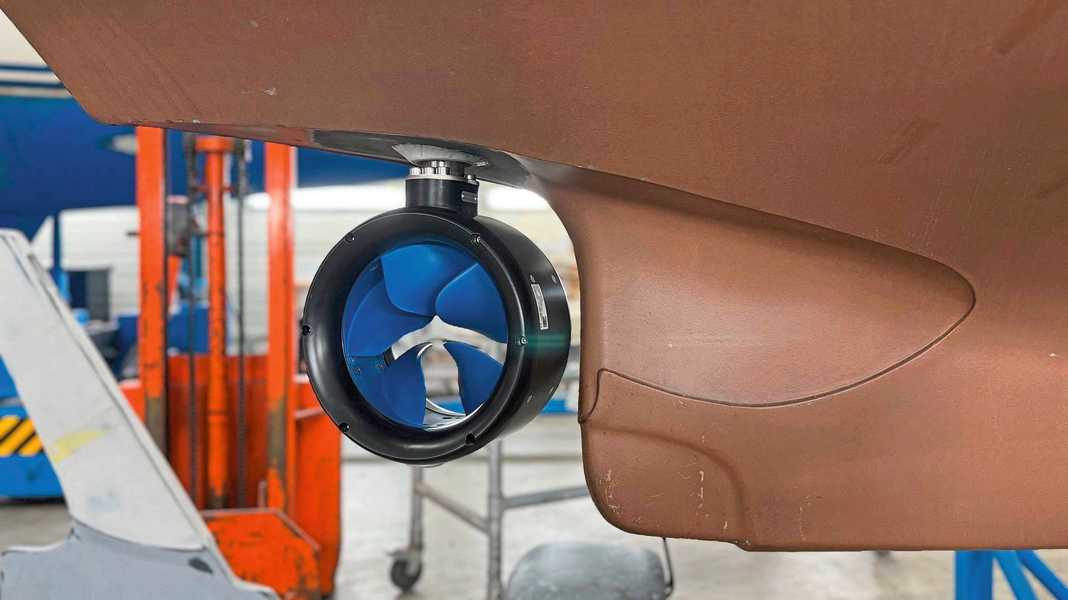
Pod drives are considered a revolutionary technology in the field of modern marine propulsion. The term "pod" describes the underwater part in which the entire electric drive system is integrated. The electric motor is located directly in this pod under the boat's hull and drives the propeller.
Advantages of pod drives
One particular advantage is the ability to rotate the gondola 360 degrees, which makes manoeuvring much easier - especially in narrow harbours. In normal leisure boating, however, a non-rotating version is almost always installed. For those who do not want to do without a diesel drive, there is the option of installing a hybrid system.
One of the biggest advantages of pod drives is their high efficiency. Thanks to direct power transmission and a streamlined design, they consume less energy, which also reduces emissions. The compact design also saves space inside the vehicle, as there is no need for shaft systems or Z-drives. The additional space can then be used for batteries, which in turn increase the range. Other advantages include reduced noise levels, as the motor is located underwater in the nacelle, and virtually maintenance-free operation.
Wide range of applications
Pod drives can be used for a wide range of applications. They make manoeuvring easier on superyachts, while they save both space and energy on cruise ships. Icebreakers benefit from their efficiency when constantly switching between forward and reverse travel, and ferries appreciate their quiet operation and lower emissions. The TT-Line ferry "Akka", which operates between Travemünde and Trelleborg, is an example of their manoeuvrability: even with a length of 190 metres, the ship is easy to manoeuvre thanks to pod drives.
Challenges and costs
Despite the many advantages, there are also challenges. Pod drives are more expensive to purchase than conventional systems, and repairs require specialised knowledge. The range of purely electric drives is limited, which makes it necessary to use additional batteries, which in turn take up space and add weight. Nevertheless, the technology is becoming increasingly popular due to its ease of use, high manoeuvrability and efficiency.
Market overview and cost examples
This trend was also evident at METS 2024 in Amsterdam, where numerous manufacturers presented new systems. For this market overview, we researched information on pod motors on the Greenboatsolutions.de website. The platform offers a large selection of electric drive systems and detailed technical data.
This allowed us to create a practical overview of different models and their characteristics, including cost examples. The same battery type with the appropriate charger was always included in the costs. The 48-volt Ultimatron 150 Ah battery costs €2,499 on the website, while an Aces charger for 48 volts with 25 A and 1,350 watts costs €449. However, these components can be customised as required. We have also concentrated on motors with a thrust of around four tonnes. This thrust usually replaces a 15 hp outboard motor. Only the Vetus pod drive is only available with ten kilowatts.
Installation and technical advice
Installation should be carried out by experts, as it is essential that the holes in the hull are correctly sealed. Elias Kerlinski from Greenboatsolutions.de explains: "Simply sealing the flange is not enough, as water could penetrate the bolts. We are happy to advise customers who want to do the installation themselves."
Unusual solutions such as Rim Drive Technology are also being used. Established brands such as ePropulsion, Torqeedo and Aquamot are leading the way in refit projects for boats up to six tonnes, says Kerlinski. However, choosing the right system requires advice and technical expertise to realise the full potential of the technology
Hy.G Pod
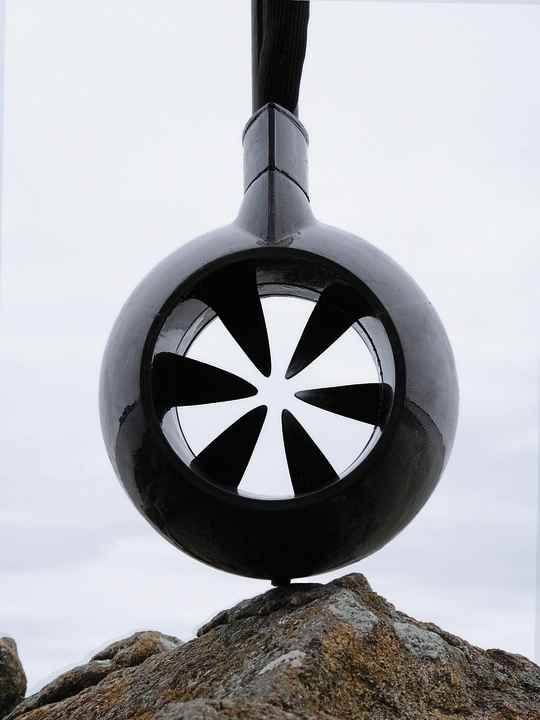
The Hy.G Pod is an electric pod motor with an input power of 7 or 16 kW. According to the manufacturer, the 7-kilowatt version has a thrust comparable to a 20-hp petrol engine. It is suitable for boats weighing up to 4,500 kg and operates with a voltage of 48 V. The motor is characterised by virtually silent operation and infinitely variable speed control. Thanks to the water cooling, the motor remains reliable even at high continuous output. A special feature of the Hy.G 6 is recuperation, which makes it possible to recover energy while travelling (with another motor) or at a standstill and slowly recharge the batteries from a speed of around 4 knots. The system is also available in a swivelling version. Incidentally, as the pod is made of carbon fibre, it also looks good.
Hy.G builds battery banks especially for its engines (5,649 euros). A charger is included. All in all, 14,548 euros change hands.
SeaDrive
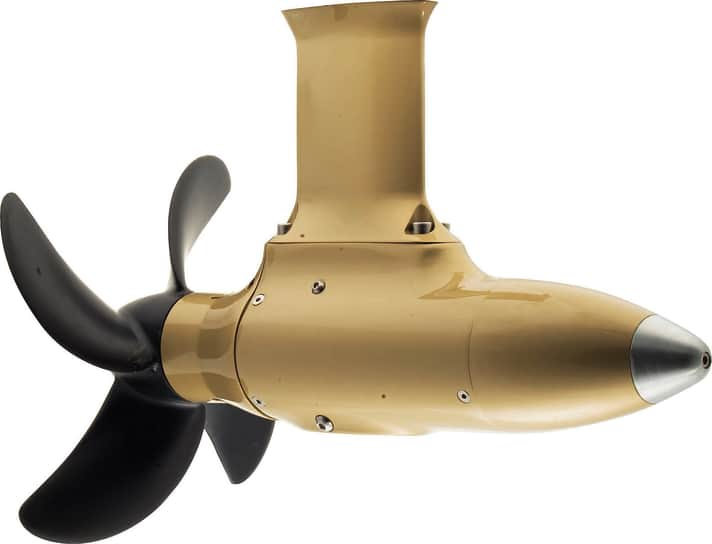
The SeaDrive Pod is an electric pod motor with an input power of 7.5, 20 or 30 kW. The 7.5 kW motor is suitable for boats weighing up to 4,000 kg and operates at a voltage of 48 volts. The motor is characterised by virtually silent operation and infinitely variable speed control. Its streamlined design minimises water resistance. The total weight of the drive is 45 kg, with the pod itself weighing 19 kg. Optionally, the motor can be rotated 180° to help with manoeuvring. It can be controlled via tablet, smartphone, PC or joystick, with multiple control positions possible. All SeaDrive pods are saltwater-resistant and offer the option of recuperation.
As a cost example, we refer to the 7.5 kW variant. With a 48-volt battery (€2,499) and a charger for the 48-volt system (€449), the total comes to €11,387.
Aquamot



The Austrian electric motor manufacturer Aquamot probably offers the largest selection of pod motors. There are no fewer than 19 models to choose from. They are divided into different models. Firstly, there is the Trend series and the Professional series. The power range extends from 1.1 kW to 25 kW for the Trend series and from 1.9 kW to 27.8 kW for the Professional series. This means that boat weights of up to 12.5 tonnes can be moved. The required voltage varies. A maximum of 15 kW at 48 volts is possible. Then it goes up to 96 volts. The system has a colour display for reading the engine and battery data, a propeller and a throttle lever. Recuperation is not possible. The costs differ between the Trend and Professional series.
The trend version is slightly cheaper. The eight-kilowatt version has a unit price of 6,199 euros. A colour display and a throttle are included in the scope of delivery. With battery and charger, the price is 9,147 euros.
The Professional F80e with eight kilowatts of shaft power costs 7,099 euros. Including a 48-volt charger and a 150 Ah battery, it costs 10,047 euros.
ePropulsion

The Pod-Drive from ePropulsion is also quiet and, according to the manufacturer, maintenance-free. A particular advantage is the ability to recover power through recuperation and recharge the battery when the boat is sailing. Five different power classes are available. The first is a 1 kW version for boats up to 1.5 tonnes. This is followed by three and six kilowatts. The latter can power sailing yachts up to 2.7 tonnes. All three versions work with 48 volts. If you want more power, 12 kW (six tonnes boat weight) and 20 kW (ten tonnes boat weight) are available. However, this brings us to 96 volts, which also means that whoever installs the system needs a high-voltage licence. The limit is 60 volts.
The most popular variant with six kW costs 3,249 euros. It also comes with a remote control, 150 Ah battery and charger. All in all, this adds up to around 6,000 euros.
Mitek Pod

The system operates at 48 volts and is available in four different power levels. The smallest motor delivers 5 kW, the other models 7.5, 12 and 15 kW. With the smallest version, boats up to 2.5 tonnes can be propelled. With the 15 kW version it is 7 tonnes. Even with the most powerful version, the voltage remains at 48 volts, which simplifies installation and reduces costs. If the motor is not needed, the propeller blades can simply be folded in - similar to a conventional diesel drive on a sailing boat. The system is powered by external batteries, which must be housed in the ship. LiFePO4 or the lighter Li-NMC batteries can be used for this purpose. Safety functions such as emergency stop switch, overvoltage protection and low battery alarm are available.
The price for a 7.5 kW system starts at 9,999 euros. However, there is also a throttle, the connection cables, the charger and a 48-volt battery. All of this adds up to a price of 14,086 euros.
E-Tech
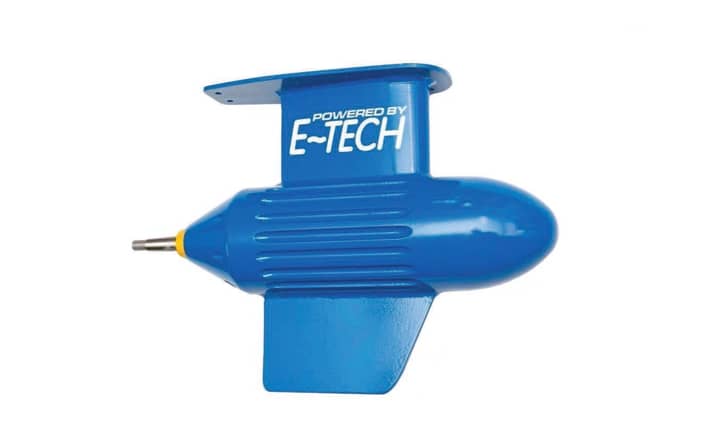
E~Tech offers a total of eight different power levels. The entry level starts at 4.3 kilowatts. This version is designed to power boats up to three tonnes. The largest possible version is currently 40 kW. According to the manufacturer, this is for boats weighing up to 30 tonnes. Up to ten kW, the manufacturer sticks with a 48-volt system. After that, it goes up to 150 volts. The propeller is made of brass, but has to be purchased separately (11-12 inches: 369 euros). Joystick, ignition lock, motor control and everything else you need is included in the scope of delivery. Recuperation is possible with the motors.
The 7 kW version with propeller, charger and batteries costs €11,616 at Greenboat Solutions.
Torqeedo Cruise
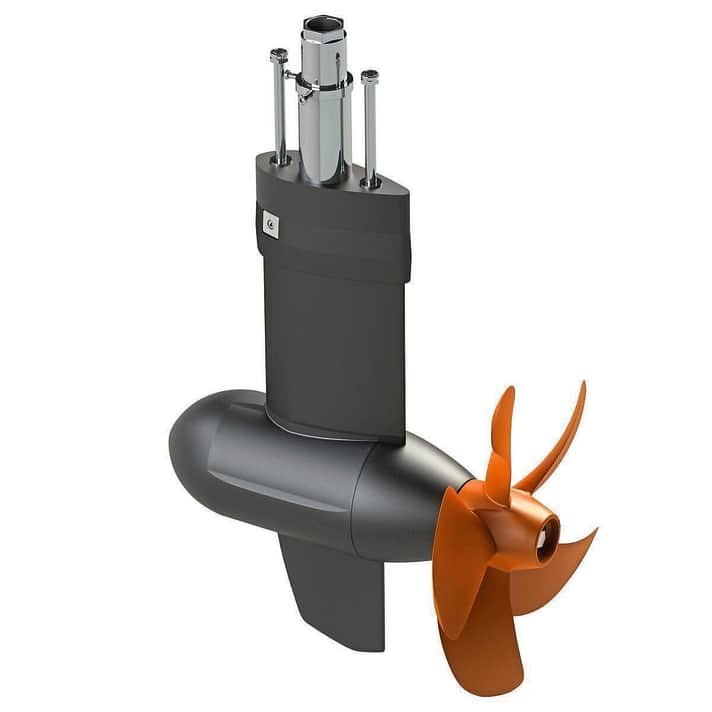
With the Cruise series, Torqeedo also offers a pod motor. The power levels are divided into three variants. Starting at three kW for smaller boats up to 1.5 tonnes. This is followed by a six kW variant for boats of around three tonnes. Those who need more thrust can take a look at the Cruise 12.0. The boat can then weigh around six tonnes. All three motors are infinitely variable and of course equipped with safety features such as emergency stop, range information and battery charge status. Recuperation will also be possible. In addition, all drives are operated with 48 volts. The propeller is made of plastic.
Once again, we are using a complete cost example for the six kW version. With throttle, charger, battery and Torqeedo Cruise 6.0 FP (€4,599), the total cost is €7,200.
Rim Drive
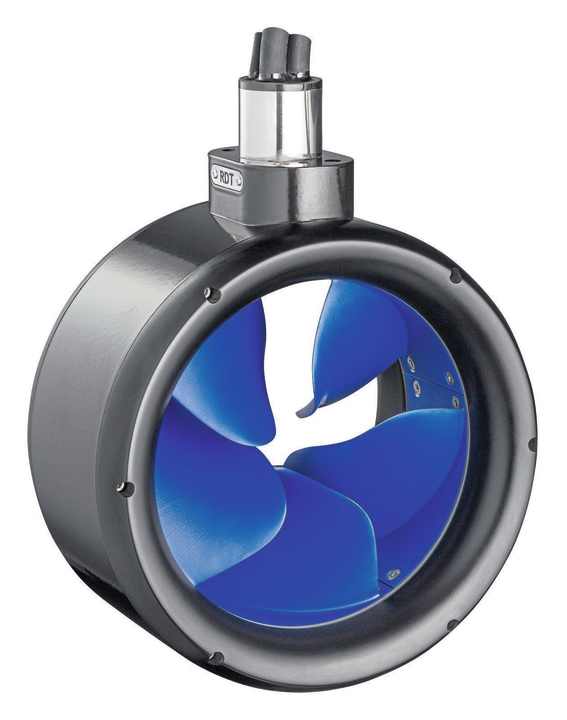
The rim drive pod drive is probably one of the most unusual on the market. It is not based on a normal propeller as usual, but on a rim with blades mounted inwards. However, the technology is not new. The first rim drives have been in use since 1929. This motor is also available in a rotating version as an option. A maximum output of 50 kW is available. This should enable ships of up to 20 tonnes to be moved. However, you are then also operating in the high voltage range of 400 volts. To illustrate a comparable cost example here too, we are again assuming a motor with a thrust of around four tonnes. With Rim Drive technology, the input power is eight kW. According to the manufacturer, this can move up to four tonnes. The weight of the motor is only 14 kg.
In addition to the motor (€10,999), a cable set, a control lever, a safety kit and, of course, a charger and batteries are required to install the system. All of this together costs 15,316 euros.
Water World
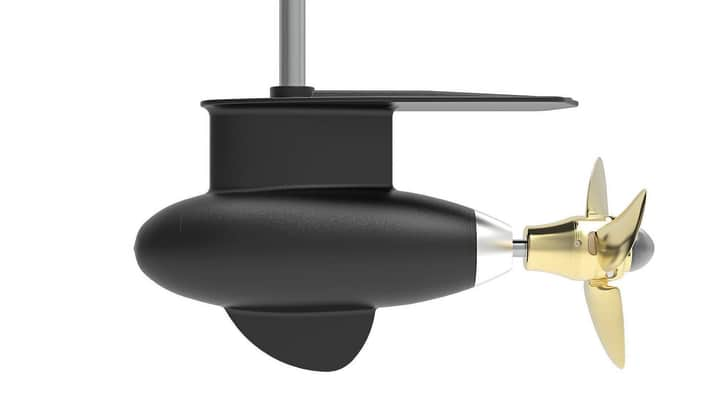
The WaterWorld pod drive is available in a power range from 2 to 18 kilowatts. Made from saltwater-resistant aluminium, it impresses with its durability and corrosion protection. The motor enables infinitely variable speed control for precise steering and has an on-board computer. External batteries can also be integrated into the system with the optional BatteryLink module. Various mounting kits offer flexible installation options, including fixed or rotating as well as folding or fixed propellers. The eight-kilowatt version is of interest to us.
In addition to a battery and charger, a mounting kit (65 euros), a propeller (699 euros) and additional accessories worth 252 euros are required for operation. The total cost therefore amounts to 13,263 euros.
Vetus
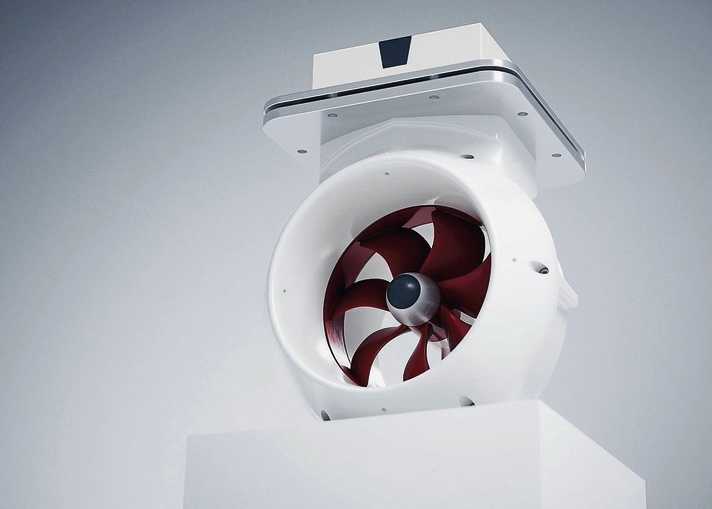
The Vetus E-Line pod motor is an electric pod motor with an input power of 10.2 kW, which is roughly equivalent to the thrust of a 20 hp internal combustion engine. It is suitable for boats weighing up to 8,000 kg and also works with a voltage of 48 V. The motor is characterised by virtually silent operation and infinitely variable speed control. Thanks to the water cooling, the motor remains reliable even at high continuous output. The integrated battery monitor protects against deep discharge and damage.
The complete package with 48-volt battery, charger and a necessary control lever (770 euros), which is not included in the scope of delivery, costs 14,817 euros.

